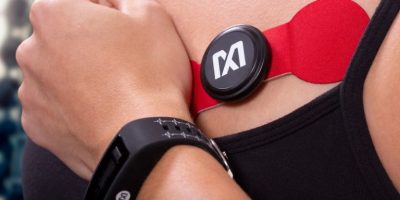Band and monitor track ECG and heart-rate signals
The Max-Health-Band evaluation and development platform, a wrist-worn heart-rate and activity monitor, features the MAX86140 optimised optical pulse-oximeter/heart-rate sensor, the MAX20303 wearable power-management solution and Maxim’s motion-compensated algorithms.
The Max-Health-Band heart-rate and activity tracker demonstrates system-level performance at the IC level and can be used to evaluate analogue front end (AFE) and power-management ICs.
It includes motion-compensated algorithms to extract useful data for health and fitness applications based on photoplethysmography signals.
In addition, it streams algorithm output and raw data from the health sensors via Bluetooth onto a smartphone app for customer algorithm development.
Algorithm output data provided includes heart rate, heart-rate variability (HRV), step count, and activity classification.
For high accuracy, the heart-rate and activity monitor collects beat-to-beat physiological data about the heart. The Maxim ICs within the band require allow it to last for seven days on a single charge. These ICs are also approximately one-third smaller to deliver a compact, comfortable form factor for consumers.
“With these end applications, software companies and startups can significantly accelerate time to market by using them right out of the box,” said Andrew Baker, executive director of the industrial and healthcare business unit at Maxim Integrated.
“The Max-Health-Band, for example, is a complete solution allowing customers to design a heart-rate and activity monitor in its entirety – using either their own algorithms or the one we created for them.”
The Max-Health-Band is available via Maxim’s website, priced $200. It includes the company’s Maxim’s motion-compensation algorithms as well as an Android-based app for a complete, wrist-worn activity-tracking solution; available for white-box licence.
The Max-ECG-Monitor evaluation and development platform features the MAX30003 low-power, clinical-grade AFE which analyses data and accurately tracks ECG and heart rate to provide insight to customers for clinical and fitness applications.
It comes in two form factors – a wet electrode patch for clinical applications and a chest strap for fitness applications.
Developers can run their own fitness or medical ECG-based applications and algorithms.
Part of the Movesense ecosystem for biometric and motion sensor solutions, the Max-ECG-Monitor runs an open application programming interface (API) for developing in-device apps for various ECG-based use cases showing heart-rate signals at rest or during high motion activity.
“Developers creating monitoring devices don’t always have the special expertise in measurement technology, visual and mechanical industrial design, signal processing, and algorithm development. On the other hand, consumers want comfortable wearables with long battery life and reliable accuracy,” said Jussi Kaasinen, business development director at Movesense.
“Fully productised and commercially available Movesense-based applications such as the Max-ECG-Monitor enable customers to go to market quickly, while also providing high performance and comfort,” he said.
The Max-ECG-Monitor costs $150 and includes an ECG module that can attach to the chest for fitness applications or wet electrode patches for clinical application. It is also available for white-box licence.




